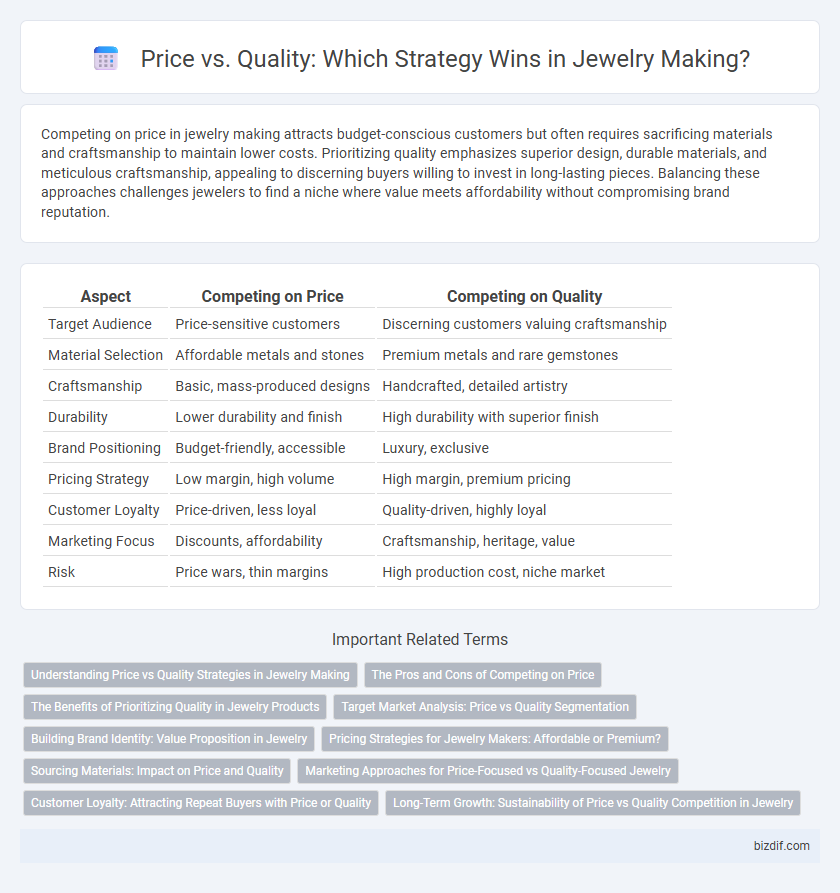Competing on price in jewelry making attracts budget-conscious customers but often requires sacrificing materials and craftsmanship to maintain lower costs. Prioritizing quality emphasizes superior design, durable materials, and meticulous craftsmanship, appealing to discerning buyers willing to invest in long-lasting pieces. Balancing these approaches challenges jewelers to find a niche where value meets affordability without compromising brand reputation.
Table of Comparison
| Aspect | Competing on Price | Competing on Quality |
|---|---|---|
| Target Audience | Price-sensitive customers | Discerning customers valuing craftsmanship |
| Material Selection | Affordable metals and stones | Premium metals and rare gemstones |
| Craftsmanship | Basic, mass-produced designs | Handcrafted, detailed artistry |
| Durability | Lower durability and finish | High durability with superior finish |
| Brand Positioning | Budget-friendly, accessible | Luxury, exclusive |
| Pricing Strategy | Low margin, high volume | High margin, premium pricing |
| Customer Loyalty | Price-driven, less loyal | Quality-driven, highly loyal |
| Marketing Focus | Discounts, affordability | Craftsmanship, heritage, value |
| Risk | Price wars, thin margins | High production cost, niche market |
Understanding Price vs Quality Strategies in Jewelry Making
Jewelry makers must balance price and quality strategies to attract target customers and sustain profitability. Competing on price involves sourcing affordable materials and streamlining production to offer budget-friendly pieces, often appealing to mass markets. Prioritizing quality focuses on craftsmanship, premium gemstones, and durability, attracting discerning buyers willing to pay a premium for uniqueness and longevity.
The Pros and Cons of Competing on Price
Competing on price in jewelry making can attract a larger customer base by offering affordable options, increasing sales volume and market penetration. However, lower prices often mean reduced profit margins and may lead to perceptions of inferior quality, diminishing brand prestige. This strategy risks long-term sustainability as continuous price cuts can erode craftsmanship standards and undermine the value of handmade or high-quality materials.
The Benefits of Prioritizing Quality in Jewelry Products
Prioritizing quality in jewelry products enhances brand reputation, leading to increased customer loyalty and higher perceived value. High-quality materials and craftsmanship result in durable, timeless pieces that justify premium pricing and reduce returns. This focus on excellence attracts discerning buyers and distinguishes the brand in a crowded market dominated by price competition.
Target Market Analysis: Price vs Quality Segmentation
Target market analysis in jewelry making reveals distinct segments based on price sensitivity and quality preference, with budget-conscious buyers prioritizing affordability and trend-driven designs while premium consumers demand craftsmanship, exclusive materials, and durability. Competing on price appeals to mass-market customers seeking value and frequent purchases, whereas focusing on quality attracts niche audiences willing to pay a premium for artisanal uniqueness and long-term investment pieces. Understanding these segments enables jewelers to tailor marketing strategies and product development, optimizing brand positioning within competitive price-quality spectrums.
Building Brand Identity: Value Proposition in Jewelry
Competing on price in jewelry making often undermines brand identity, as it shifts focus from craftsmanship to cost-cutting, potentially diminishing perceived value. Emphasizing quality through superior materials, intricate designs, and artisanal techniques builds a distinct value proposition that resonates with discerning customers seeking timeless pieces. A strong brand identity rooted in quality fosters customer loyalty and justifies premium pricing, creating long-term competitive advantage in the luxury jewelry market.
Pricing Strategies for Jewelry Makers: Affordable or Premium?
Jewelry makers face a strategic choice between pricing jewelry affordably to capture a broader market or positioning pieces as premium to emphasize craftsmanship and exclusivity. Affordable pricing attracts volume sales but risks perceived lower value, while premium pricing reinforces brand prestige and enables higher margins. Analyzing customer demographics, material costs, and market trends helps jewelers optimize prices to balance competitive advantage with profitability.
Sourcing Materials: Impact on Price and Quality
Sourcing materials directly influences both price and quality in jewelry making, where bulk purchasing of lower-grade metals reduces costs but compromises durability and finish. Opting for ethically sourced, high-purity gemstones and metals elevates product quality, attracting discerning customers willing to invest more. Strategic supplier relationships and certification standards ensure consistent material quality, enhancing brand reputation and justifying premium pricing.
Marketing Approaches for Price-Focused vs Quality-Focused Jewelry
Price-focused jewelry marketing leverages promotional campaigns, discounts, and value-based messaging to attract budget-conscious consumers seeking affordability and style. Quality-focused marketing emphasizes craftsmanship, superior materials, and exclusivity through storytelling, detailed product descriptions, and high-end brand positioning targeting discerning buyers. Effective segmentation in marketing strategies aligns messaging with consumer priorities, balancing perceived value against product excellence to optimize brand appeal and market share.
Customer Loyalty: Attracting Repeat Buyers with Price or Quality
Customer loyalty in jewelry making hinges more on quality than price, as buyers seek lasting value and craftsmanship in their pieces. Superior materials, unique designs, and meticulous attention to detail cultivate trust and encourage repeat purchases. While competitive pricing can attract initial buyers, consistent quality fosters deeper emotional connections and long-term loyalty.
Long-Term Growth: Sustainability of Price vs Quality Competition in Jewelry
Competing on price in jewelry making often leads to short-term sales boosts but can erode brand value and customer loyalty over time due to perceived lower quality. Focusing on quality fosters sustainable long-term growth by attracting discerning customers willing to invest in timeless, durable pieces crafted with premium materials and skilled techniques. Prioritizing quality enhances reputation, supports higher profit margins, and builds a resilient brand in the competitive luxury jewelry market.
Competing on Price vs Competing on Quality Infographic

 bizdif.com
bizdif.com